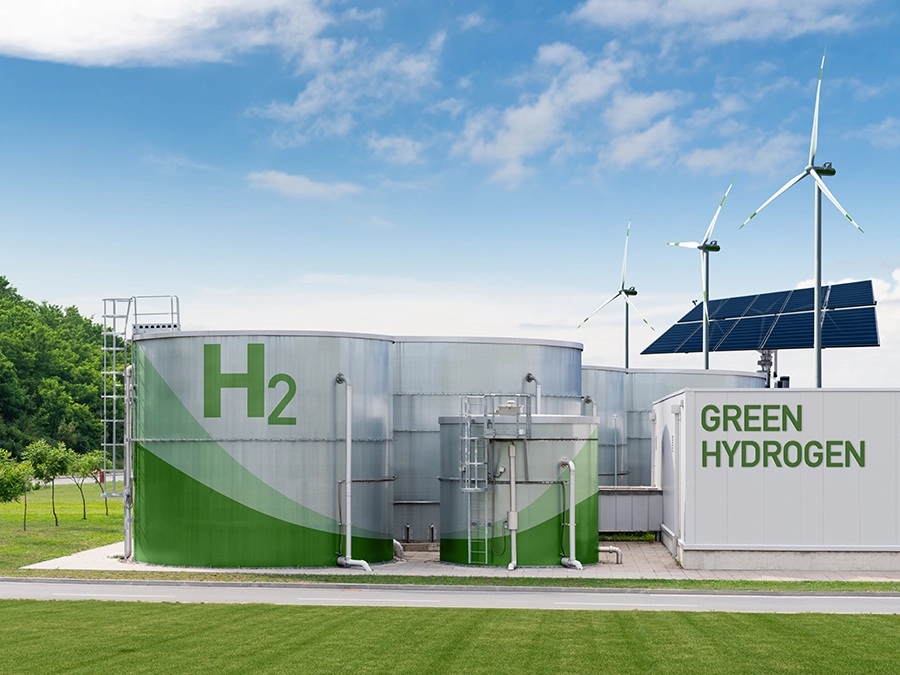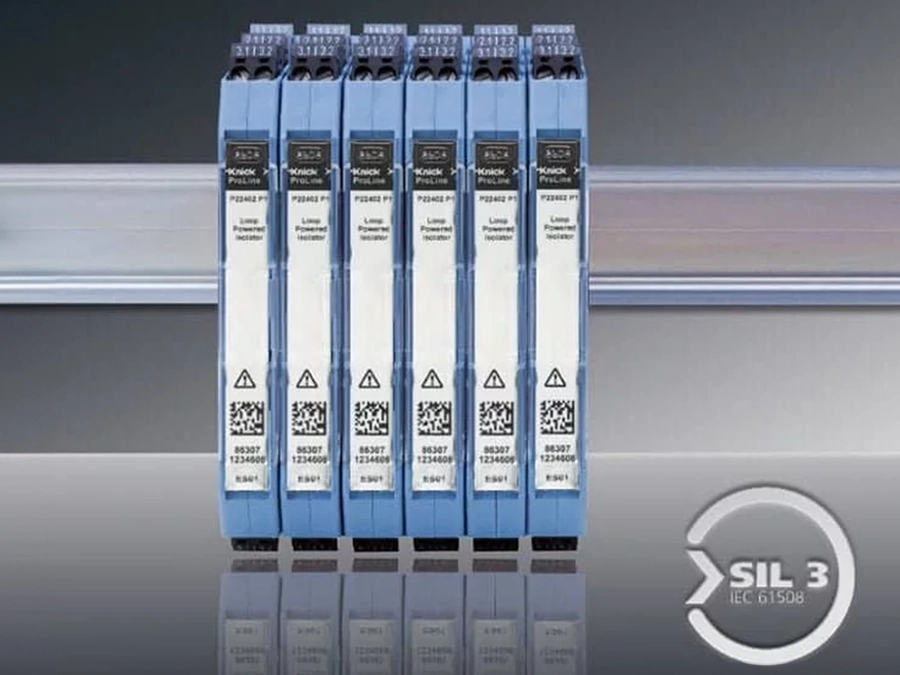Shortcuts
Tags
Latest Posts
Stack and String Voltage Measurement in Electrolyzers and Fuel Cells

Green hydrogen plays a key role in the energy transition. As a zero-carbon fuel with high energy density, hydrogen will be the best option in the future for transporting renewable energy or storing it remotely. The output of electrolyzers that produce hydrogen with electricity from wind farms and solar power stations is constantly growing. In order to guarantee the maximum efficiency and process reliability of these systems, continuous condition monitoring of the electrolysis cells, which are integrated in large quantities, is necessary. To achieve this, failsafe transducers that safely isolate high potentials and measure direct currents up to (currently) 1500 V with high precision are required.
Increasingly High Power
Depending on the manufacturer, in modern electrolyzers, up to several hundred electrolysis cells are wired into stacks that can be replaced as complete units in case of failure or maintenance. Since individual electrolysis cells require average operating voltages between 1 and 4 V DC, stack voltages can be several 100 V DC. Further, in larger-scale electrolyzers, multiple stacks can be combined into individually controllable strings with significantly higher total voltages. The current trend is to string voltages up to 1500 V DC. Today, electrolyzers with electrical power consumption in the two-digit megawatt range are in operation.
Fuel cells, on the other hand, support the efficient, clean conversion of hydrogen into electricity. They use a process that is the inverse of the electrolyzer process: It generates electricity through the reaction of hydrogen and oxygen. Like electrolyzers, fuel cells consist of cells and stacks that are wired to create high voltage strings.
Voltage Monitoring for Purposes of Diagnostics
In order to detect defects and signs of wear on electrolysis or fuel cells, it is necessary to continuously and accurately measure stack and string voltages. Occasionally, the voltages at sub-units of stacks are also measured. In these cases, the measured voltages are lower, but high potential differences occur due to the wiring. Accordingly, the transducers must be highly isolated. It is also necessary to monitor currents and temperatures. To do this, the transducers used must not only meet high standards of precision and robust isolation, but also be failsafe and maintenance-free. Since the electrolyzers are housed in containers next to wind farms or photovoltaic power stations, which are typically set up in remote locations, system availability significantly depends on the reliability of the measuring technology.

Perfect Solutions: High Voltage Transducers in the P40000 Series
With their extreme long-term stability, the high voltage transducers in the P40000 series offer optimal solutions for voltage, current, and temperature measurement in electrolyzers. The transducers guarantee a basic isolation up to 3600 V and reinforced isolation up to 1800 V. Due to the conservative and fully encapsulated electronics design, they achieve an MTBF of 2165 years (based on field data). They also feature outstanding transmission properties with a gain error of < 0.3 % of the measured value and, like all products from Knick, do not require recalibration over their entire service life. Further, the compact housing for DIN rail mounting simplifies their integration into retrofit applications as well.
Latest Posts
Interface Technology
Hydrogen, SIL, Energy
Process Analytics
Pharma, Sensor, Conductivity
Interface Technology
Hydrogen
Interface Technology
Interface Technology
Exhibition, InnoTrans
Related Posts

Jun 2025
Interface Technology
Hydrogen, SIL, Energy
P45000 SIL 2 / SIL 3: Voltage measurements in applications with functional safety

Sept 2024
Interface Technology
Hydrogen
Stack and String Voltage Measurement in Electrolyzers and Fuel Cells

Sept 2024
Interface Technology
New 30 mV Shunt Resistors for Knick Transducers

Sept 2024
Interface Technology
Exhibition, InnoTrans
Innovations at InnoTrans 2024 for rolling stock and DC traction power supply

May 2022
Interface Technology
Energy
Energy storage - the handshake between renewable energy and electric vehicles

Feb 2022
Interface Technology
P52000VPD, Voltage
P52000VPD voltage presence detector reliably detects voltages up to 4200 V DC

Sept 2021
Interface Technology
USA, Exhibition
Knick Interface at Battery and Electric & Hybrid Vehicle Technology Expo

May 2021
Interface Technology
Quadruple Standard Signals in Just One Signal Conditioner

Apr 2021
Interface Technology
Hydrogen
Electrical measurement and process analytics for hydrogen production

Mar 2021
Interface Technology
High-Voltage Transducer, USA, P44000
Condition Monitoring of High-Voltage Motors

Mar 2021
Interface Technology
Pulse frequency conditioner for speed sensors

Nov 2020
Interface Technology
High-Voltage Transducer, Voltage, P42000D2
Worldwide smallest transducer up to ±2200 V

Aug 2020
Interface Technology
DC
Importance of broad-range power supplies for DC electrical measurement

Jul 2020
Interface Technology
High-Voltage Transducer, DC, P29000
Measuring Photovoltaic Degradation

Jun 2020
Interface Technology
High-Voltage Transducer, USA
Electrical Measurement Solutions: Control from 480 to 4800 Volts

Jun 2020
Interface Technology
High-Voltage Transducer
Benefits of High Voltage Transducers versus Instrument Transformers

Nov 2019
Interface Technology
DC, USA, Current
Shunt Resistor versus Hall Effect Technology

Mar 2018
Interface Technology
MTBF beyond 3000 years: A snap hook for your plant

Jan 2018
Interface Technology
UL
Knick Products Comply With UL - What Does That Mean?

Nov 2017
Interface Technology
High-Voltage Transducer, P50000
High-voltage transducer offers more safety on railway vehicles

Feb 2017
Interface Technology
P41000TRMS
True RMS Measurement with P41000TRMS

Feb 2017
Interface Technology
SIL, P22400





